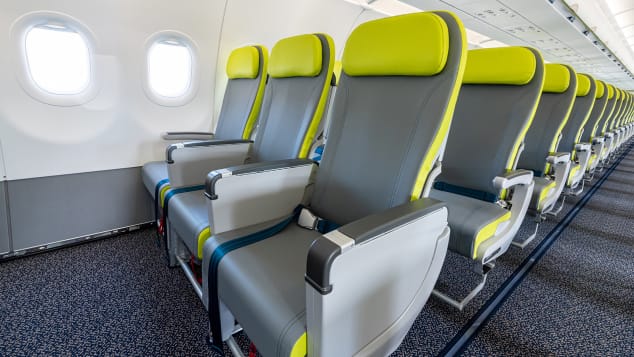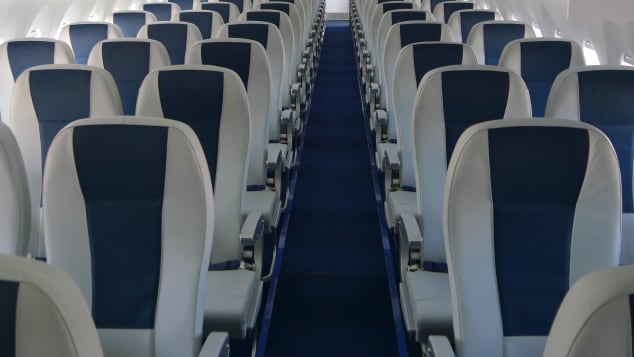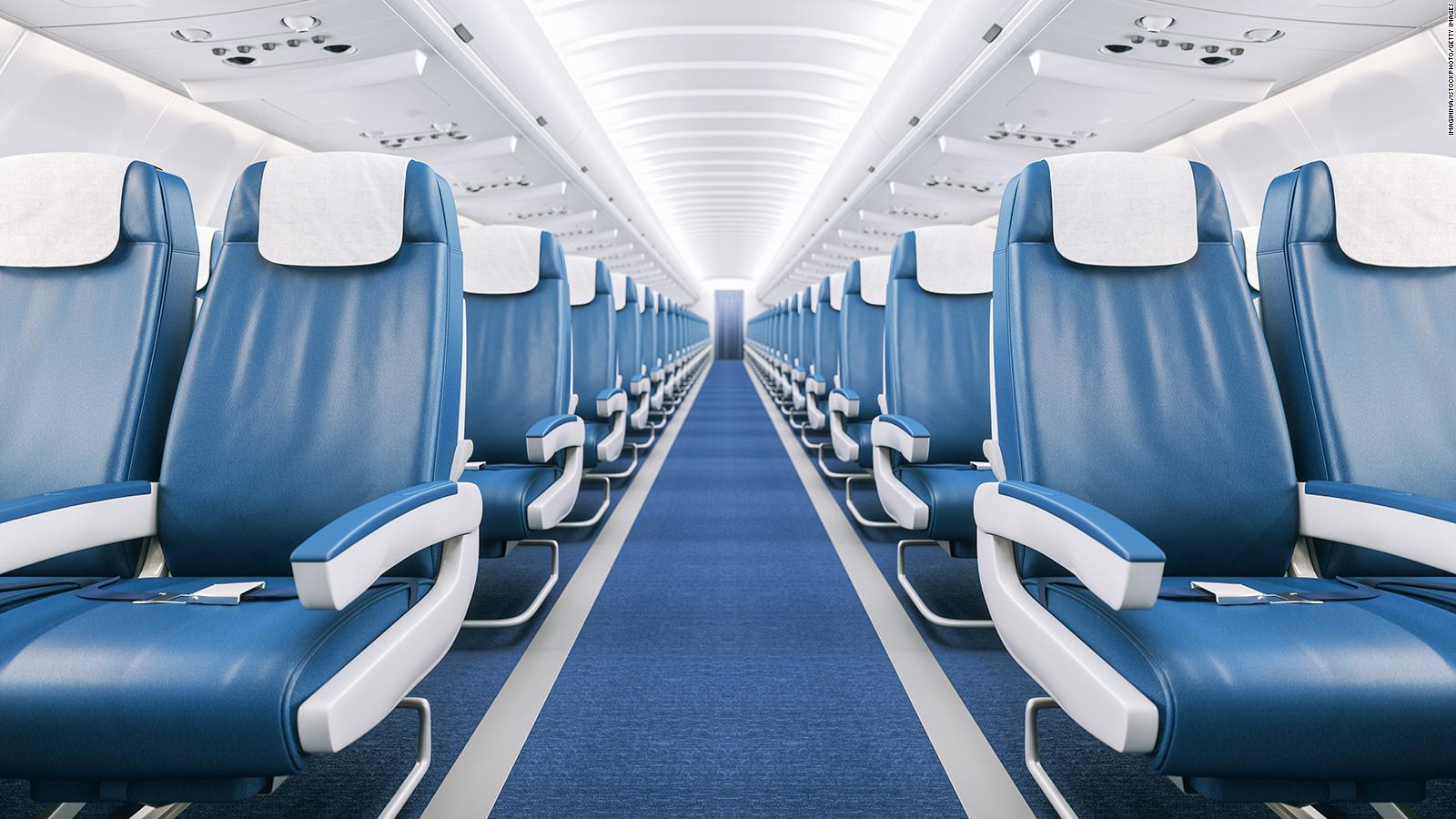(CNN) — The recline button on airplane seats is so controversial that it has inspired an entire mini-industry of devices to prevent the passenger in front of you from leaning into your space.
There was a time when all airline coach seats had a built-in recline button. Nowadays, there are seat models that do not have this option.
What made deck chairs disappear in some places? Is it a good or bad thing? Just because a passenger can recline their seat, should they?
As with many things in the aviation industry, it depends on who you ask.
Let's talk about how reclining works: In its simplest form, there's a mechanism hidden in the frame beneath the seat cushion that contains a pivot, cables that connect it to the button on the armrest, and an air container that returns the seat to its upright position. Seat manufacturers call it kinematics: parts that move.
For airlines, this represents a cost, primarily the cost of maintenance: any type of mechanism is vulnerable to breakage, either due to normal wear and tear or because passengers do not handle the aircraft carefully.
Secondly, it is the cost of weight, because these mechanisms can quickly add weight to the aircraft. Today, the newest and lightest aircraft seats weigh between 7 and 10 kilograms per passenger. Any weight saved means less fuel needed to transport it.
And third, and in some ways more important, it's the cost of the boycott, because if passengers quarrel over the etiquette of reclining seats, the flight attendants have to act as marshals, as if it were the yard school. In some cases, passengers became so unruly that flights had to be diverted for safety reasons.
Every centimeter matters

Although you can lie down, not everyone thinks you should. Credit: Kumar Sriskandan / Alamy Stock Photo
What if the seats don't recline?
In the late 2000s, a new generation of ultra-light chairs began to appear on the market, and part of what made them so light was that they did not have a reclining function. Some marketing genius came up with describing it as “pre-reclining,” which places the backrest at an angle between completely upright and slightly reclined.
Initially, it was mainly intended for low-cost carriers. These airlines, which usually operate flights lasting only a few hours, are known for removing all non-essentials from their operations.
One of the first airlines to adopt it was Britain's Jet2, a European holiday operator, which in 2009 chose a pre-reclining seat from then-nascent seat maker Acro, which revolutionized the way airlines think about seating.
The Acro seat, then called Clark and now Series 3, was different in a few key ways.
The lack of recline was one of these reasons, but another was the innovative way the seat was sculpted to create a concave 'cubic' shape of the seat and backrest.
From the rear, this shape meant that taller passengers could place their knees on either side of the 'bucket', gaining a few centimeters of space.
These two centimeters are really important. On single-aisle economy class aircraft, such as the Boeing 737 or Airbus A320, there are about 30 rows, and the previous generation seats were spaced about 76 centimeters apart, that is, the distance between one point of the seat and the same point of the seat in front.
If the airline can provide one inch of space per row, that's 30 inches across the entire plane, which equates to a whole extra row of seats.
In just over a decade, several seating manufacturers have invented pre-reclining seats and other ways to save space.
One of the best-respected companies is German seat maker Recaro, known outside the aviation world for its racing car seats. In addition to full economy class seats for long-haul flights, with a reclining and folding tray, Recaro Aircraft Seating also offers reclining seats for short-haul flights.
Advance chair backs

Replacing reclining seats with “pre-reclining” seats could mean fewer angry passengers. Credit: Stefan Krüger/airbus/p202106006
“The airline can choose a pre-set backrest angle position of 15 or 18 degrees in the seat configuration process,” explains Mark Heller, Recaro CEO. “This helps provide more comfort by increasing the seat back angle or meeting special conditions with specific numbers of passengers.”
“The main advantage is a larger living space, since reclining does not interfere with the passenger's living space. In addition, lower overall cost, fewer moving parts in the seat, greater reliability and ease of maintenance, lower weight and cost, by not requiring mechanisms, kinematics, etc. till then.
The special provisions Heller mentions are usually what the industry calls “max pax,” i.e. the maximum number of approved passengers for the aircraft. There are currently 244 passengers on board the narrow-body Airbus A321neo, an aircraft on which some airlines with large business class seats in the front carry fewer than 150 passengers.
It should be clear that the 244-seat version of that plane, or even a version with 230 seats or more, will not be the most spacious.
But in recent years, seat makers have found ways to make it seem like there's more knee room: slimming the backrest, moving the frame away from your knees, and improving leg room.
In recent years, sleek seating that was primarily used on low-cost airlines has made its way onto full-service airlines as well, especially since these compete directly with low-cost carriers.

Pre-reclining seats can be an advantage on short flights. Credit: Adobe Stock
One way they do this is by providing economy seats to passengers with extra legroom at the front of the cabin, which can have a fuller seat model with reclining capability and AC power outlets, at an additional cost, whereas in regular economy class it can be reclined. Pre-installed and does not have any connections or just a USB socket.
These cabins are called hybrids, so pay attention next time you board: The seat fabric may change color from row to row, the movable headrest may disappear, or the seat covering may change from fabric to leather.
So, are pre-reclining seats an advantage or a disadvantage?
I've covered the industry as a journalist for a decade and a half and more than 40 years of aviation. In the end, I came to the conclusion that they are positive when used mainly on short flights lasting a few hours, especially because they avoid potential fights with the person in front and behind you.
However, long-haul flights are different, and reclining in these seats is here to stay, but with the added benefit of the extra leg room developed for pre-reclining seats.
Just be polite on board and look behind you before you recline, recline slowly and gently, and put the backrest upright when everyone is eating, preferably without the crew asking you to do so.
Editor's note: This article was originally published in 2023.

“Beer enthusiast. Subtly charming alcohol junkie. Wannabe internet buff. Typical pop culture lover.”


:quality(85)/cloudfront-us-east-1.images.arcpublishing.com/infobae/OSGMES3WAFEBTE2GAHWFBH4XTM.jpg)
:quality(85)/cloudfront-us-east-1.images.arcpublishing.com/infobae/UY7LJVZAN5BDLPK7YZ6TXLS25Y.jpg)



More Stories
The secret to always having free WiFi, even if you don’t know the password
China’s Cape Canaveral is booming, fueled by the lunar mission and space program
NASA revealed the true color of the oceans